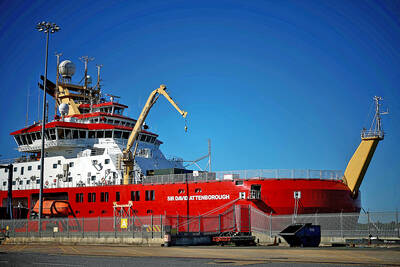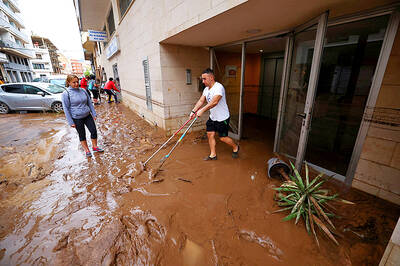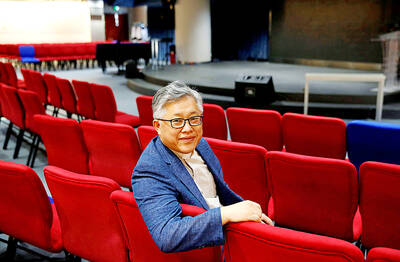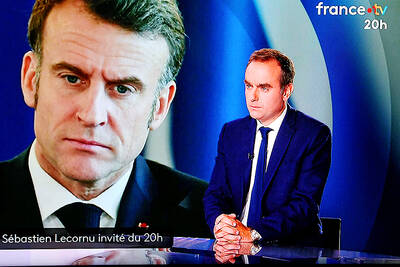The Japanese government yesterday hailed embattled Prime Minister Taro Aso’s meeting with US President Barack Obama, but the opposition slammed the talks as being devoid of content.
Aso on Tuesday became the first foreign leader to visit Obama in Washington, where both leaders pledged to cooperate in fighting the global economic crisis and in responding to a potential North Korean missile test.
‘FRANK DIALOGUE’
“Both the leaders were able to hold a frank dialogue and build a personal relationship,” Chief Cabinet Secretary Takeo Kawamura said.
“It was very significant to confirm that the world’s largest and second-largest economies should work together to tackle global issues under the alliance,” Kawamura told a news conference in Tokyo after the summit.
But the largest opposition group, the Democratic Party of Japan (DPJ), said that Aso, whose public support ratings have plummeted, no longer represented the country.
“We cannot expect effective negotiations by a prime minister who has lost the people’s trust,” DPJ President Ichiro Ozawa told reporters.
NOT ENOUGH
“I’m afraid the talks had nearly no content,” said Ozawa, who is leading in opinion polls ahead of elections later this year. “I don’t think America seriously discussed things with Aso.”
DPJ Secretary-General Yukio Hatoyama charged that “if [Aso] feels overjoyed to be the first to be invited to the presidential office, it just means that [Japan’s] diplomatic subservience to the United States will continue.”
Aso remains under intense pressure after a series of political problems including the resignation of his finance minister last week for appearing drunk at a major international meeting.
Aso, who must call elections by September, has seen his Cabinet’s approval ratings steadily decline from more than 40 percent when he took office five months ago to just 11 percent, a poll this week found.

STEPPING UP: Diminished US polar science presence mean opportunities for the UK and other countries, although China or Russia might also fill that gap, a researcher said The UK’s flagship polar research vessel is to head to Antarctica next week to help advance dozens of climate change-linked science projects, as Western nations spearhead studies there while the US withdraws. The RRS Sir David Attenborough, a state-of-the-art ship named after the renowned British naturalist, would aid research on everything from “hunting underwater tsunamis” to tracking glacier melt and whale populations. Operated by the British Antarctic Survey (BAS), the country’s polar research institute, the 15,000-tonne icebreaker — boasting a helipad, and various laboratories and gadgetry — is pivotal to the UK’s efforts to assess climate change’s impact there. “The saying goes

Floods on Sunday trapped people in vehicles and homes in Spain as torrential rain drenched the northeastern Catalonia region, a day after downpours unleashed travel chaos on the Mediterranean island of Ibiza. Local media shared videos of roaring torrents of brown water tearing through streets and submerging vehicles. National weather agency AEMET decreed the highest red alert in the province of Tarragona, warning of 180mm of rain in 12 hours in the Ebro River delta. Catalan fire service spokesman Oriol Corbella told reporters people had been caught by surprise, with people trapped “inside vehicles, in buildings, on ground floors.” Santa Barbara Mayor Josep Lluis

Police in China detained dozens of pastors of one of its largest underground churches over the weekend, a church spokesperson and relatives said, in the biggest crackdown on Christians since 2018. The detentions, which come amid renewed China-US tensions after Beijing dramatically expanded rare earth export controls last week, drew condemnation from US Secretary of State Marco Rubio, who on Sunday called for the immediate release of the pastors. Pastor Jin Mingri (金明日), founder of Zion Church, an unofficial “house church” not sanctioned by the Chinese government, was detained at his home in the southern city of Beihai on Friday evening, said

TICKING CLOCK: A path to a budget agreement was still possible, the president’s office said, as a debate on reversing an increase of the pension age carries on French President Emmanuel Macron yesterday was racing to find a new prime minister within a two-day deadline after the resignation of outgoing French Prime Minister Sebastien Lecornu tipped the country deeper into political crisis. The presidency late on Wednesday said that Macron would name a new prime minister within 48 hours, indicating that the appointment would come by this evening at the latest. Lecornu told French television in an interview that he expected a new prime minister to be named — rather than early legislative elections or Macron’s resignation — to resolve the crisis. The developments were the latest twists in three tumultuous